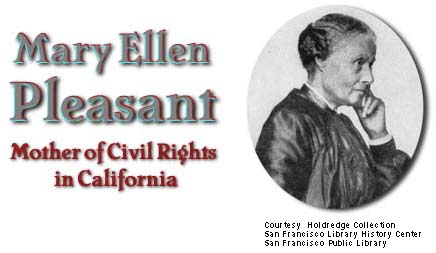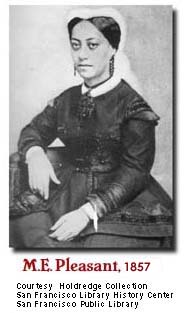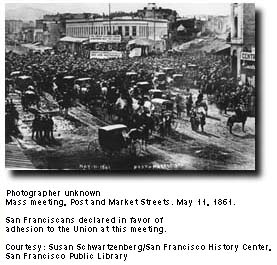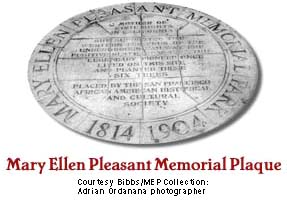


Called the Mother of Civil Rights from work begun in the 1860s, her achievements went unsurpassed until the 1960s. Pleasant was the most talked-about woman in 1880's San Francisco. When other African Americans were rarely mentioned, she claimed at least 100 articles. Her dramatic life -- an underpinning of "the American Story" -- encompasses slavery, abolition, the gold rush, the Civil War, Reconstruction, and the turn of the century; she helped shape early San Francisco, covertly amassing a joint fortune once assessed at $30,000,000! Americans today deserve to know her because she could love across boundaries of race and class without losing sight of her goal - equality for herself and her people.However, until now Pleasant's true saga has been obscured. For, although this daring woman won battles and faced life, success, power, desertion, betrayal, and death head on, she lost the battle for her own good name: At the end of her life, her covert schemes began to go awry, and her enemies "scandalized" her name. By the turn of the century, the popular press had labeled her "Mammy Pleasant," "angel and arch fiend," "madam and murderess" -- indiscriminately infusing her story with myth, misinformation, gossip, and half truths. These tabloid accounts of her day became the basis for the 20th-century social histories that writers still quote blindly.
Before Susheel Bibbs' research and recovery of lost writings and accounts by Pleasant and her contemporaries, it was difficult to unravel fact from the fiction of Pleasant's colorful life. However, now the story is being told -- a story vital for today's Americans because she could love across boundaries of race and class without losing sight of her goal - equality for herself and her people. Moreover, Pleasant embodied the American spirit of enterprise whether working in Eastern abolition, pursuing her fortune in California, or in fighting for civil rights and jobs for African Americans, escaped slaves, or women. Of course, Pleasant always infused what she did with risk and ambition, and so her story is an exciting one.
The real question is "Where did she get her courage, and how did she learn to love amidst a life of violent struggle?" The story that follows and the new documentary film that is being scripted answers those questions and should solve the many mysteries of Mary Ellen Pleasant.
Click here to return to our Home Page
Home PageClick here for News and a Schedule of Presentations:
Schedule of PresentationsClick here to donate to the upcoming Pleasant Film documentary (tax deductible)
Tax deductible donations (Select "supported projects" and "M" to find "Meet Mary Pleasant")Click here to learn about the upcoming documentary Film Information Page Now, read about MEP:

The Legacies of Mary Pleasant (abridged version)*
The Early Years
According to one of her various memoirs, Pleasant, was born a slave near Augusta,Georgia between 1814 and 1817, and according to ships records and confirming testimony, she arrived in San Francisco in April 1852. Part of her reason for coming to San Francisco was to escape persecution under the Fugitive Slave Law of 1850, which had made her life as a slave rescuer in the East increasingly dangerous. However, the courage to do that and other great deeds surely started in childhood.
At birth, Mary had no last name. In her first memoir she said that she was born the illegitimate child of a Virginia governor's son (John H. Pleasants) and an enslaved Haitian Voudoo* priestess, so Mary had to create "names" for herself, and that she did. After witnessing the torture and death of her mother at the hand of a plantation overseer, Mary had to make her way and name largely on her own. However, she emerged strong and able to love inclusively despite such difficult beginnings. Note: (*Above, the word Voudoo, meaning "spirit," refers to the religion that emerged in Haiti from a combination Yoruba, Fon, Bambara, Congolese, and other cultures of Africa, and not to the derogatory connotations given it today.)
In her memoir, Pleasant once said that, at the age of nine, she was bought out of slavery by a sympathetic planter. No one really knows his name or if it was true because the names and dates she gave often conflict. Pleasant was a survivor who altered and embellished her story in several memoirs to offset criticisms levied against her. However, here is information that has withstood some scrutiny:
Pleasant said that her rescuer from slavery sent her to New Orleans' Ursaline Convent at the age of about 9 and subsequently to work as a free servant for a friend named Louis Alexander Williams, a merchant in Cincinnati. The rescuer's promise was that, after she had gained some education and served the Williams for some time without pay, she would be given her freedom. However, Williams, in debt, resentful of the child's insolence, and ultimately jealous of his wife Ellen's affection for the child, did not educate Mary and eventually placed her into nine years of informal indenture (Mary called it being "bounded out.") in Nantucket, MA with an aging, liberal Quaker merchant called Grandma Hussey. "Bounded out" (indentured) servants could be of any race, and Mary, a mulatto child who (by her own insistance was) very fair until later life, was told not to reveal her black heritage - a heavy burden for a girl of about eleven, which Pleasant was to endure again.
 Later, when her service had ended, circa 1841, the Hussey-Gardners helped this brilliant, talented, twenty-something young woman become a tailor's assistant in Boston. On her own and at large, she became a paid church soloist although her religious affiliation was Catholic.
Later, when her service had ended, circa 1841, the Hussey-Gardners helped this brilliant, talented, twenty-something young woman become a tailor's assistant in Boston. On her own and at large, she became a paid church soloist although her religious affiliation was Catholic.In Nantucket, Mary incorporated Ellen's Williams' name, becoming "Mary Ellen Williams," and she learned business, ultimately serving as a much-loved clerk in Grandma's Huckster shop (general store). Although she could not read or write then, she said in her final, unpublished memoir, "I could recall the accounts of a whole day, and she [Grandma] would set them down and they would be right as I remembered 'em." Clearly she had a prodigious memory, and clearly Mary became smart and witty as she grew older, and according the letters that support Mary's story, she was much loved by the Husseys, despite the fact that she was "in service." The family included the Phoebe Hussey and later Capt. Edward W. Gardner clan, well known in Nantucket. Mary loved them back and adopted their liberal, abolitionist beliefs (not the norm in early Nantucket) as well as the principles of equality that they taught her. Thus, in Nantucket Mary imbibed the spirit of enterprise, equality, and love of humanity that she would use throughout her later life and work -- In Nantucket, she took the shackles of slavery from of her mind!
In Boston, Mary Ellen Williams soon met and married James W. Smith, a wealthy mulatto contractor/merchant. According to a letter by Mary, James (a mulatto from Philadelphia via Ohio) also "passed" for white (Cuban) to serve as a spy for William Lloyd Garrison's abolitionist paper, THE LIBERATOR, and as an Underground Railroad operative. Soon both Smiths served that railroad -- the trackless series of homes and volunteers where men, women, and youth helped slaves escape to freedom by various routes (tracks). Some of these routes led slaves to New Bedford, New York, Canada, Nova Scotia, and Mexico.
In the early years Mary merely supported James' work, and James Smith's "track" as a slave rescuer and Virginia "spy" ran slaves to Nova Scotia from Virginia. James' white father had actually left him a plantation in Virginia, and James serviced it with freed slaves (freedmen) many of whom, according to Mary, he purchased out of slavery. This land now seems to have been parceled out and to be located near now Charles Town, W. Virginia.
Sadly, however, Smith seems to have wanted Mary because her appearance fit his needs; thus, he was helpful but cruel to her, and although Mary says that she grew to love and admire James, she also expressed strong feelings in her final memoir about Smith's restriction and trickery. Anyway, Smith (who some say was ill) died sometime between 1844 and 1848 after exhibiting symptoms that Mary's second husband later equated with poisoning. This led some to suspect Mary of "hastening" Smith's death, but nothing ever came of this accusation. James Smith left Mary with land and a fortune ($45,000 in bonds) which she exchanged for gold; by 1848 Mary was a wealthy woman.
By 1850 Mary Williams Smith had married James'friend and foreman, John James Pleasance, but she continued Smith's slave rescue work between New Bedford, MA, and Ohio, not for Smith, but due to her own inner calling. Legend says that, disguising herself as a jockey, she stole onto plantations to rescue or alert slaves of rescues and that Mary soon became a much-hunted and infamous slave rescuer. Mary's scribe (Charlotte Downs) and a news story published after her death did support this story.
So, in 1850, with slavers hot on her trail, Mary Pleasance (Pleasants Anglicized) was forced to flee to her Nantucket family and then to New Orleans to "hide out" with the relatives of her second husband, John James (J.J.) Pleasance. Pleasance was not related to her father, John H. Pleasants, as some have alleged. In fact he told friends that the Pleasants name had simply been assigned to his father and that his real name surname was "Christophe." Thus, when she had to flee to the West, Mary Ellen Pleasance, listed herself as "Mme. Christophe."
. Once they had reached New Orleans, JJ, a ship's cook, took off to scout a safer life for them in California gold-rush country, but Mary stayed behind to own up her heritage as a leader of her people by studying with the social-activist Voodoo Queen Mam'zelle. Marie LaVeaux. LaVeaux had piloted a way to use Voodoo to aid the disenfranchised of New Orleans, and Mary, who should have inherited a voodoo priestancy from her mother, wanted to learn it. Being a priest (a Mambo) of Voodoo meant being a healer, a religious leader, and a helper to her people. Said the only eye witness of this study, LaVeaux's alleged granddaughter, Liga Foley, "She (LaVeaux) was teachin' Mrs. Pleasants Voodoo so she could use it some way." So, from Mam'zelle LaVeaux Mary learned to mentor her people (African Americans and disenfranchised women) and to effect methods of gaining and using the secrets of the powerful to garner their aid of the powerless. This "Heritage of Power" -- this "model" for leverage and social change that LaVeau passed to Pleasant would lead Mary to become San Francisco's "Black City Hall" and, later, "The Mother of Civil Rights in California." Soon JJ sent for Mary and her money (which, said Mary, he loved dearly) and being again hunted again for slave rescuing, Mary fled to San Francisco.

Mary arrived in rough an' ready San Francisco on April 7, 1852-- a place with about 40,000 people and 400-700 drinking and gambling establishments. The locals consumed a million gallons of liquor a year and committed five murders every six days. There were six men to every woman. It was not a safe place, but Mary was up to the challenge. Once there, because she had no freedom papers, she was again forced to use a white identity to thwart capture under California's Fugitive Slave Act. Under this law anyone without freedom papers could be captured and wrested into slavery. Still Mary, by day as "Mrs.Ellen Smith," white boardinghouse steward/cook, and as "Mrs. Pleasants," community activist/priestess/entrepreneur, found ways to help her people. As Mrs. Smith, she served the wealthiest and most influential men in San Francisco, and using their regard for her as well as the "LaVeaux model" of leveraging their secrets for favors, she was able to get jobs and privileges for "colored" people in San Francisco. This power and effectiveness caused local blacks to nickname her "The Black City Hall."

As Mrs. Pleasants, Mary used her money to help ex-slaves fight extradition and to help African Americans start businesses in California. She became an expert capitalist, owning every kind of business imaginable, and she prospered. However, her people suffered as the 1853 European immigrations took menial jobs once reserved for them and further in 1857-58 as anti-black sentiment increased under the strain of national depression. So, when many blacks left oppression in California for Canada, Mary decided left for Canada too - not to reside there permanently - but, as she once said in a letter, to free her former brother-in-law from his re-capture in slavery and to help abolitionist John Brown end slavery forever.
In Canada, she and JJ seemed to have worked together. She bought land with his help to enable Brown to house escaped Virginia slaves and both served on an abolition committee. Brown's plan was to capture the Federal arsenal in Harper's Ferry, VA, with its 90-100,000 guns with only 21 men and to establish Virginia as a slavery-free zone, thus frightening the Union into ending slavery. He also planned to ferret some Virginia slaves from that zone to Canada. Mary gave Brown money for arms and came back the following fall to ride (in disguise) in advance of Brown to alert slaves in southern Virginia of his coming. It was a naive, desperate plan, but, unlike some other Black leaders, Mary, believing that slavery had to be ended by force, was willing to support it. "I'd rather be a corpse than a coward," was always her motto.
Of course, Brown acted too soon and was hanged, and Mary narrowly escaped with her life. On her return to San Francisco in 1860, Mary, (still hunted for treason), continued to fight slavery covertly; however, after the Emancipation Proclamation and the California Right-of-Testimony of 1863 allowed her to do so safely, she openly declared her race and personally orchestrated court battles to test the right of testimony laws. In 1868 her battle for the right to ride the San Francisco trolleys set precedent in the California Supreme Court and became available to aid 20th-century civil rights.
In the 1860's and 70's Mary Pleasant went on to amass wealth through investements with her secret business partner, Scotsman Thomas Bell, an official of the Bank of California. This allowed her to become a celebrated philanthropist and business woman and to amass a joint fortune once assessed at $30,000,000. In 1883, however, she financially helped a young Southern woman challenge the powerful Senator William Sharon for divorce. This scandalous case brought ruin to all involved. Despite eventually losing this case and considerable money, she continued in good health and humor until the 1890's when age, the sudden death of her partner, twists of fate and betrayal, and bad press destroyed her reputation and she succombed to ill health.. Still Pleasant's legacy of love and courage live on. Her 1868 Trolley case set precedent in the California Supreme Court and was used in 1982 to win the first damages in a case of discrimination in that same court, but more importantly, her example of industry continues to inspire and her ability to love all people gives us a model of inclusion and humanity so needed in today's America.
Bibbs, 2001, All rights reserved.
Quotes or use of this article is prohibited without the consent of the author;
references are available to scholars through MEP Productions
This site with an older article is reproduced by Pacific Bell with permission of Susheel Bibbs.

Researcher/Producer/Enactor Susheel Bibbs plays Pleasant in chautauqua and will be Project Director for the film. She holds advanced degrees in philosophy and music and has been a scholar/enactor and grant recipient of the California Council for the Humanities since 1994. Her book on Pleasant's activisim, "Heritage of Power," will soon be followed by a TV documentary called "Meet Mary Pleasant." Bibbs is currently a lecturer at the University of California at Berkeley and a director of programs and an exhibit on Pleasant for the National Park Service's Network to Freedom Program; she is also a member of the National Chautauqua Tour. Her work chautauquas on Pleasant (musical and dramatic) have been certified by the California Council for the Humanities, which once ran their own chautauqua program, and her private research collection (extant letters, memoirs, and interviews on Pleasant and her mentor, Marie LaVeaux) has also been certified in writing by the director of that Council. Called the "foremost expert on Pleasant" in a 1999 commendation by the Supervisors of the City and County of San Francisco, Susheel was just cited for her work on Pleasant by the L.A. Afro-American Museum and the St. Louis City Museum.She is also a former EMMY-awardwinning TV executive producer (now sponsored as a non-profit by the Film Arts Foundation of San Francisco), an accomplished actress, and an acclaimed classical singer, who has own international notice for her singing and touring grants from the California Arts Council's Touring and Presenting Program and Missouri Arts Councils since 1988. Her touring musical, her dramatic chautauqua, and her exhibits on Pleasant, based on original research and rare documents, continue to be sponsored by museums, concert series, theaters, and colleges throughout the US and abroad.
Connect to the M.E.P. home page for more on the book and for links to related sites.
Presentations Available
Read below; then email us, orSelect here for a schedule of presentations or to view the M.E.P. homepage:
Schedule of PresentationsSelect here to donate online by credit card to the M.E.P. TV Documentary project (tax deductible)
Tax deductible donations (select "supported projects")
M.E.P. Homepage
The acclaimed Pleasant Enactments(chautauquas) in costume are touring: Mock talk-show chautauqua for teens (Pleasant Forum), the inspiring musical chautauqua (O Freedom!) and acclaimed dramatic chautauqua (Meet Mary Pleasant) can come to you -- They are perfect for adults or teens and greatly inspiring to women's or business groups.In all formats, Susheel Bibbs portrays Pleasant, using Pleasant's own (long-lost) words. The musical, O Freedom! (for theatres only) features period slides, accompanied art song and spirituals of the period (to a pre-recorded track), and live African drumming! A fifteen panel and a smaller six-panel exhibit complete with 90 min video is available through the National Park Service or SF Art Commission Gallery. The touring exhibits mount easily on easels in a foyer or lobby, over classroom blackboards, or on walls and can come to a site at minimal charge.
Program Format Descriptions:
The Talk Show:
The talk show, designed for teens (or adults), runs just like a TV talk show, using a local host and a question/answer format. Video, slides, and music are inserted. Guests on the show are Bibbs as Pleasant and Bibbs as herself -- the Pleasant scholar! In between there can be live drumming or storytelling! -- Great for TV too.The Musical or Dramatic Chautauqua (enactments):
Designed for adults and family audiences. Both contain an emcee intro and have three parts -- Pleasant tells her life story in Pleasant's own words, unfolding the mysteries and daring achievements of her remarkable life; the character answers questions from the audience; the scholar (Susheel) answers questions on Pleasant.The dramatic chautauqua does this in a very transportable, one-woman, drama-only form The musical is spectacular; it adds period slides, live drumming, and song to an already inspiring evening. All are fun, participatory history! To book your chautauqua, the touring exhibit, or the musical or just learn about events scheduled in your area - Email: [email protected]
Reviews of Susheel's Presentations
Hear what noted California historians had to say when they certified Susheel's enactment and its research for the California Council for the Humanities --
"Your research is extraordinary"
Shirley Ann Moore, Ph.d., California State Univ., Sacramento"Captivating, spellbinding presentation... Bibbs has done an amazing yeoman's job of historical research! She is MEP "Bravo!"
Rick Moss, Ph.D., Los Angeles' Afro-American Museum
"This should be a model for those who aspire to do chautuaqua."
Dr. Hundley, Historian, UCLA
Please Note: Take care in reading the 1950's and unpublished scholarly works on Pleasant. Most have merit but are riddled with inaccuracies because many necessary documents, memoirs, and letters were not available to them.
Try -- The book: Heritage of Power
This beautiful, coffee-table book on Mary Pleasant
is a biography and a major work in Pleasant's spiritual tradition as well.
Designed as a social history, it details Pleasant's life and the model that
Pleasant used to become "Mother of Civil Rights in California," the story of
Marie LaVeau, the great New Orleans Vodou queen, and the tools she passed to
Pleasant. It demystifies Vodoun (voodoo) in layman's
terms and explains
how it affected Pleasant and LaVeau. Don't miss this major work.
The Oakland Museum Store or California Historical Society store in San Francisco, CA and at Through Friends of the African Meeting House, Nantucket, MA.
Marcus Books (all locations) and Ancient Ways, Oakland, CA
- The Sonoma
County Museum Bookstore, Santa Rosa
- Carol's Books, Sacramento and the
Haggin Museum store, Stockton
- San Francisco African-Am. Museum bookstore,
San Francisco and Fresno; the California Historical Society bookstore, and
Marcus Bookstore, San Francisco
- "13" in Santa Cruz, CA
- The Mark Twain
Bookstore, Virginia City, NV
- Voodoo Auhentica, The Voodoo Spiritual
Temple, The New Orleans Voodoo Museum Store, New Orleans
Send mail, orders, or donations to: DKC: MEP Productions/Publications,
a division of Daya Kay Communications (DKC) c/o 477 Arlington St. San Francisco, CA 94131Email: Pleasant Mail: [email protected] (click here) to book,
or get an updated listing of presentations, book reviews, or online ordering, click here:
Last revised Sept. 27, 2002 and MAIL TO: M.E.P Productions/Publications-DKC
Original 1996 we
